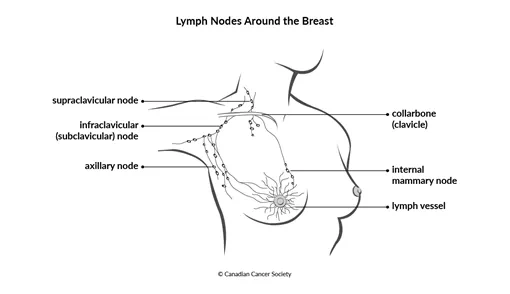Stages of breast cancer
Staging describes or classifies a cancer based on how much cancer there is in the body and where it is when first diagnosed. This is often called the extent of cancer. The healthcare team uses information from tests to find out the size of the tumour, which parts of the organ have cancer, whether the cancer has spread from where it first started and where the cancer has spread. Doctors use the stage to plan treatment and estimate the outcome (prognosis).
For breast cancer there are 5 stages – stage 0 followed by stages 1 to 4. Often the stages 1 to 4 are written as the Roman numerals I, II, III and IV. Generally, the higher the stage number, the larger the cancer is or the more the cancer has spread.
The most common staging system for breast cancer is the TNM system. To determine the stage in breast cancer, doctors evaluate the following:
- the size of the tumour and if it has grown into nearby tissues (T)
- if the cancer has spread to the lymph nodes (N)
- if the cancer has spread to distant sites (called metastasis) (M)
- the hormone receptor status
- the HER2 status
- the grade
There are several groups of

When describing the stage of breast cancer, doctors may use the words in situ, early-stage, locally advanced and metastatic.
In situ breast cancer means that the cancer cells are only in the duct or lobule where they started and have not grown into nearby breast tissue (non-invasive). In situ breast cancer is stage 0.
Early-stage breast cancer means that the tumour is 20 mm or smaller and the cancer has not spread to more than 3 lymph nodes. Or the tumour is 20 to 50 mm and has not spread to any lymph nodes. Early-stage breast cancer includes stages 1A, 1B and 2A.
Locally advanced breast cancer means that the tumour is larger than 50 mm. The cancer may have spread to the skin, the muscles of the chest wall or more than 3 lymph nodes. Locally advanced breast cancer includes stages 2B, 3A, 3B and 3C. Inflammatory breast cancer is also considered locally advanced breast cancer.
Metastatic breast cancer means that the cancer has spread to other parts of the body. It is stage 4.
Details about the tumour (T), lymph nodes (N) and metastasis (M) classifications for each stage are described below. Since staging for breast cancer also considers hormone receptor status, HER2 status and grading, staging classifications can be hard to understand. Talk to your healthcare team if you have questions about the stage you were given.
Find out more about staging cancer.
Stage 0 (carcinoma in situ)
There are cancer cells only in the lining of a breast duct. This is called ductal carcinoma in situ (DCIS).
Or there is Paget disease of the breast without any invasive carcinoma or DCIS.
Stage 1A
The tumour is 20 mm or smaller and has not spread to any lymph nodes.
Stage 1B
The tumour is 20 mm or smaller, or no tumour can be seen in the breast. A small number of cancer cells are found in the lymph nodes (called micrometastases). The group of cancer cells in the lymph nodes are no larger than 2 mm in size.
Stage 2A
The tumour is 20 mm or smaller, or no tumour can be seen in the breast. Cancer cells are found in 1 to 3 lymph nodes under the arm (called axillary lymph nodes) or in lymph nodes inside the chest around the breastbone (called internal mammary nodes) or in both areas.
Or the tumour is larger than 20 mm but not more than 50 mm and has not spread to any lymph nodes.
Stage 2B
The tumour is larger than 20 mm but not more than 50 mm. The cancer has also spread to 1 to 3 axillary lymph nodes or to internal mammary lymph nodes or to both areas.
Or the tumour is larger than 50 mm and has not spread to any lymph nodes.
Stage 3A
The tumour is of any size, or no tumour can be seen in the breast. Cancer cells are found in 4 to 9 axillary lymph nodes, or in internal mammary lymph nodes but has not spread to other parts of the body.
Or the tumour is larger than 50 mm and has spread to 1 to 3 axillary lymph nodes or to internal mammary lymph nodes. But it has not spread to other parts of the body.
Stage 3B
The tumour has grown into the muscles of the chest wall or the skin (causing an open wound, or ulcer) or both. The cancer may have also spread to 1 to 9 axillary lymph nodes or to internal mammary lymph nodes. The cancer has not spread to other parts of the body.
Or it is inflammatory breast cancer.
Stage 3C
The tumour is of any size and any of the following apply:
- The cancer has spread to 10 or more axillary lymph nodes or to lymph nodes below the collarbone (called infraclavicular lymph nodes).
- The cancer has spread to internal mammary lymph nodes and axillary lymph nodes.
- The cancer has spread to lymph nodes above the collarbone (called supraclavicular lymph nodes).
The cancer has not spread to other parts of the body.
Stage 4
The cancer has spread to other parts of the body (called distant metastasis), such as to the bone, liver, lungs or brain. This is also called metastatic breast cancer.
Recurrent breast cancer
Recurrent breast cancer means that the cancer has come back after it has been treated.
Local recurrence means that the cancer comes back in the same place it first started.
Regional recurrence means that the cancer comes back in tissues or lymph nodes close to where it first started.
Distant recurrence or distant metastasis means that the cancer comes back in another part of the body.
